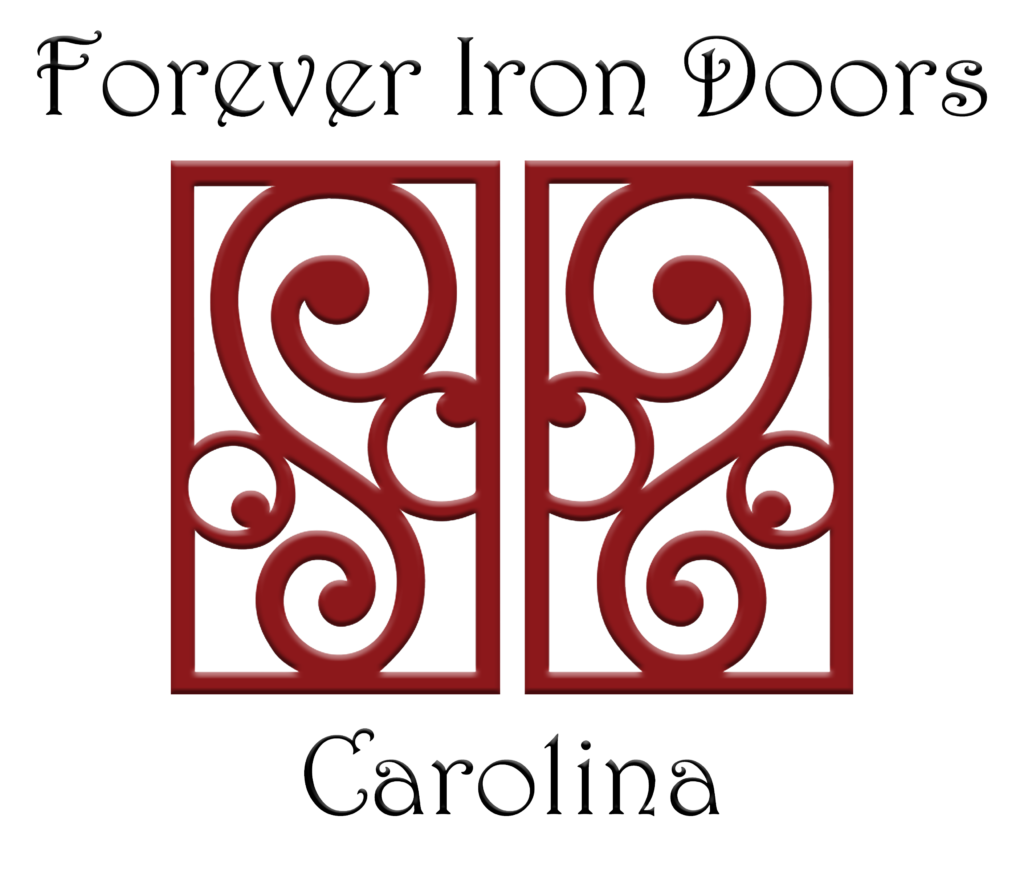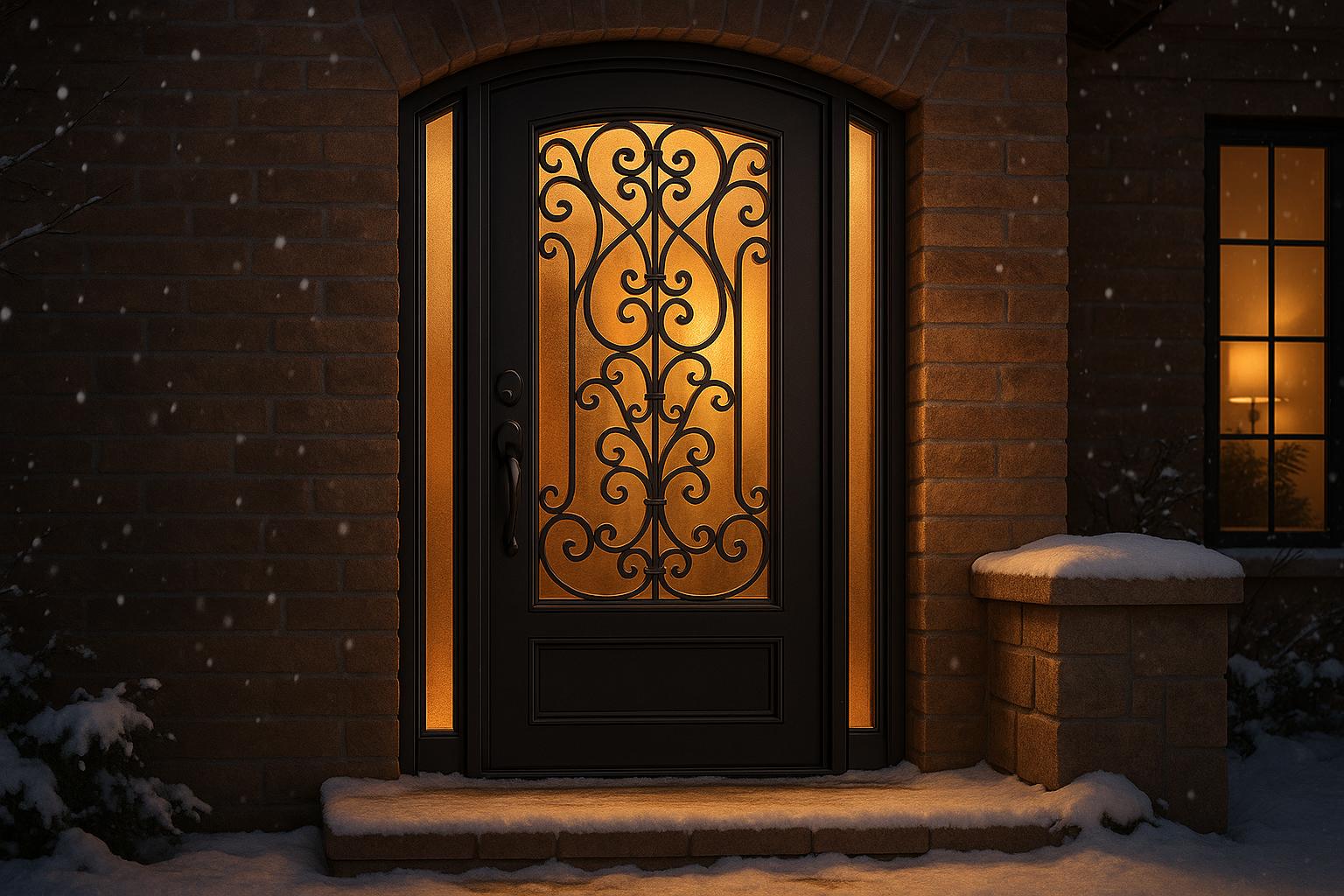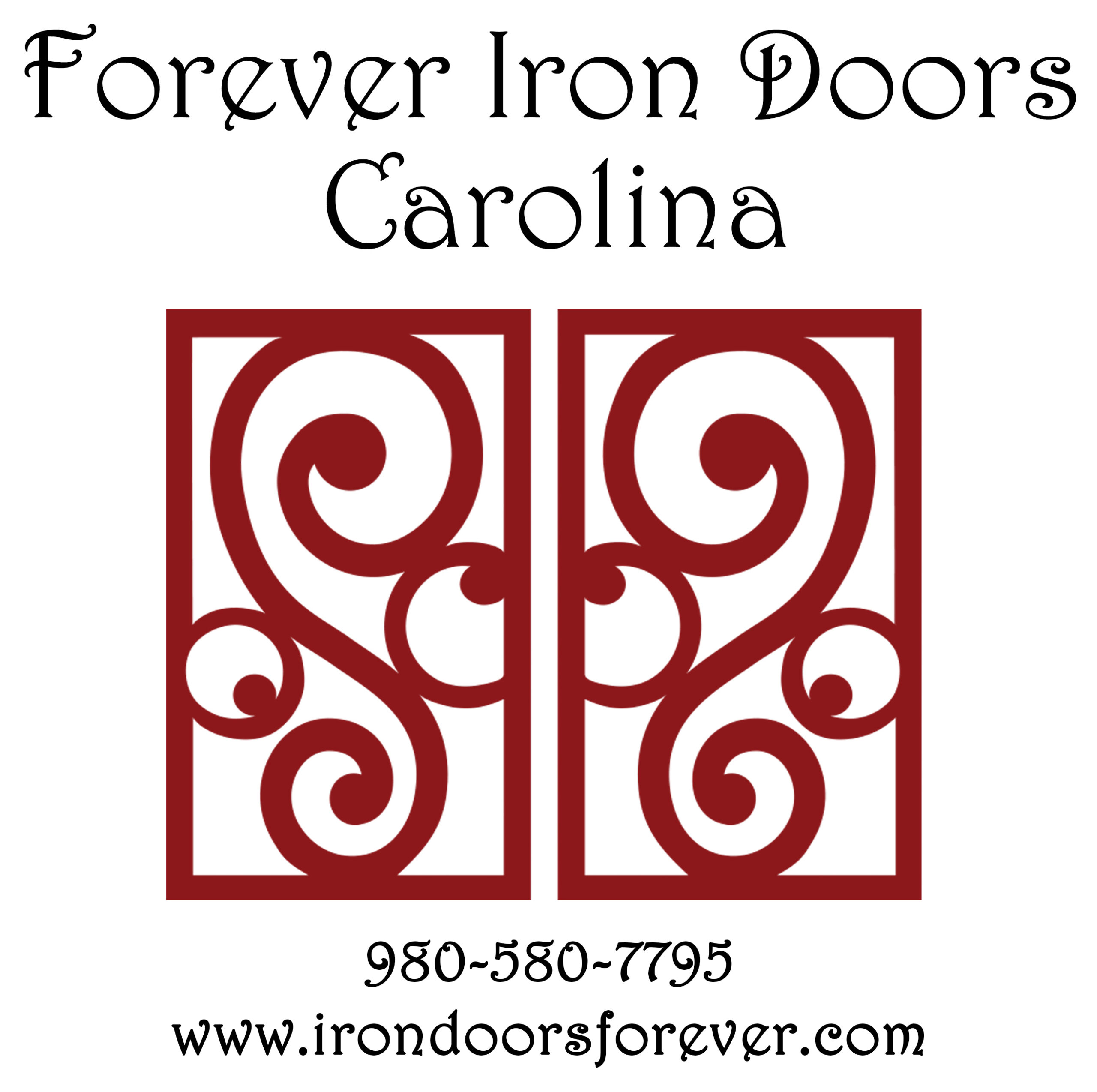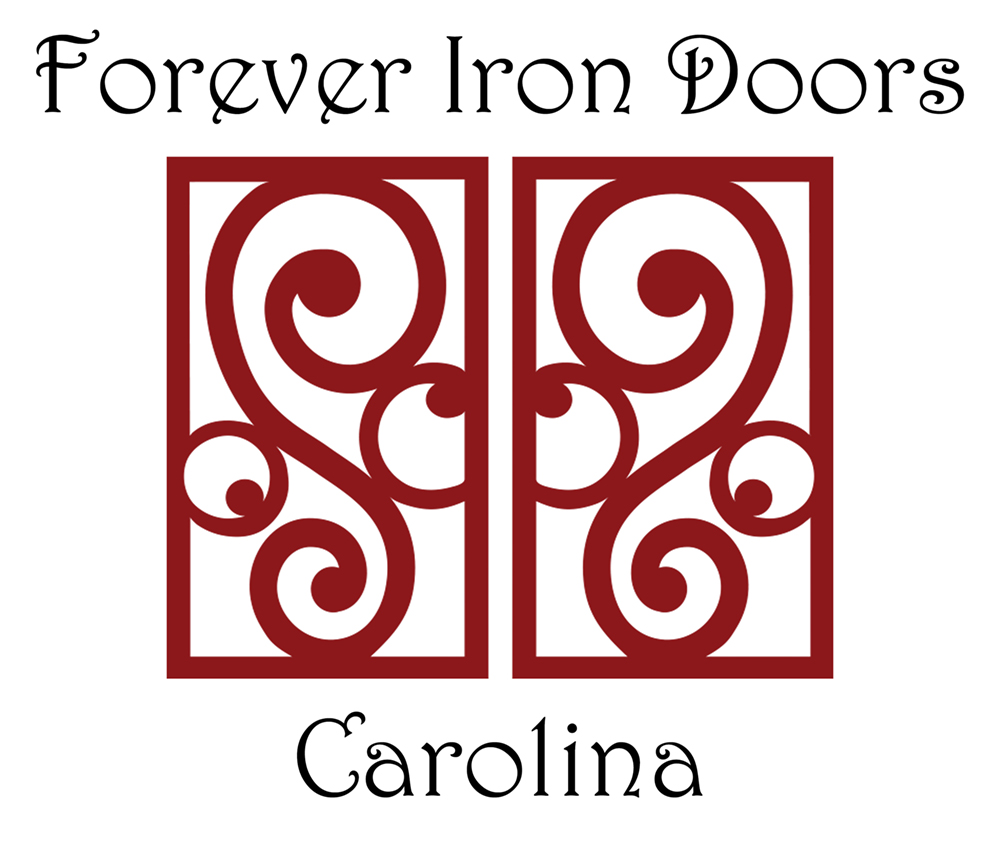Wrought iron doors are stylish and secure, but their energy efficiency depends heavily on insulation. Without proper insulation, these doors can transfer heat and cold, causing higher energy bills and discomfort in extreme weather. Modern solutions like insulated cores, thermal breaks, and weather sealing help minimize heat transfer and air leaks, making them a practical choice for both hot summers and cold winters.
Key points to consider:
- Heat Transfer: Iron is a strong conductor, so uninsulated doors can cause energy loss.
- Insulation Options: Features like polyurethane foam cores, thermal breaks, and weatherstripping reduce heat transfer and drafts.
- Glass Panels: Double or triple-pane insulated glass improves efficiency for doors with glass inserts.
- Climate Performance: Insulated doors keep homes cooler in summer and warmer in winter.
- Maintenance: Regular upkeep, like rust prevention and seal inspections, extends durability and efficiency.
For the best results, choose a door with climate-specific features like thermal breaks and reflective glass, and ensure professional installation for proper sealing.
Heat Transfer Properties of Wrought Iron Doors
When it comes to choosing a door that balances style and energy efficiency, understanding how heat moves through wrought iron is key. The natural characteristics of iron bring specific challenges that can influence your home’s comfort and energy consumption.
How Metals Conduct Heat and Cold
Thermal conductivity measures how well a material transfers heat. Materials with lower thermal conductivity provide better insulation, while those with higher values, like iron, transfer heat and cold more easily. This means that iron doors can absorb heat during the summer and lose warmth during the winter, which can put extra pressure on your HVAC system.
Issues with Non-Insulated Iron Doors
Iron doors without insulation can lead to noticeable energy inefficiencies. During the summer, they allow cool indoor air to escape while letting hot outdoor air in. In the winter, the opposite happens – warm indoor air leaks out, and cold air seeps in. This constant exchange not only results in drafts and uneven temperatures but also forces your HVAC system to work harder, driving up energy bills. These challenges highlight the importance of exploring insulation options to improve energy efficiency and maintain a comfortable indoor environment.
Insulation Methods for Wrought Iron Doors
Modern insulation techniques for wrought iron doors are designed to improve energy efficiency without sacrificing their elegant design. These methods work together to minimize heat transfer, ensuring the door remains both functional and visually appealing. By addressing energy loss, these advancements make wrought iron doors a practical choice for homeowners.
Insulated Cores and Thermal Breaks
One of the most effective ways to reduce heat transfer is by using insulated cores. Manufacturers fill the internal cavities of these doors with materials like polyurethane foam, mineral wool, polystyrene panels, or polyisocyanurate. Among these, polyurethane foam stands out for its high R-value, offering excellent resistance to heat flow.
Thermal breaks are another key innovation. By incorporating non-conductive layers – such as polyamide strips, resin barriers, or fiberglass-reinforced polymers – between the interior and exterior metal components, these breaks interrupt the direct transfer of heat or cold. This not only improves energy efficiency but also helps prevent condensation during extreme weather conditions.
Weather Sealing and Insulated Glass
Insulated cores alone aren’t enough if air leaks around the edges of the door. High-quality weatherstripping, applied along the entire perimeter of the door frame, creates a tight seal that reduces drafts and prevents air leakage. Materials like silicone, rubber, and specialized foam compounds are commonly used for weatherstripping because they maintain their effectiveness across a wide range of temperatures. Additionally, installing a door sweep at the bottom of the door further minimizes air infiltration.
For wrought iron doors with glass panels or sidelights, glazing options significantly impact insulation. Double- or triple-pane insulated glass units are particularly effective. These units trap air or inert gas between the glass layers, adding another layer of insulation that complements the core materials and enhances overall energy efficiency.
How Insulated Iron Doors Work in Different Climates
Insulated wrought iron doors are designed to minimize heat loss in the winter and reduce heat absorption in the summer. Their ability to adapt to various climates makes them a practical choice for homeowners aiming to maintain indoor comfort year-round.
Performance in Hot Summer Weather
During the sweltering summer months, insulated wrought iron doors act as a barrier against outdoor heat, helping to keep indoor spaces cooler. Many models include low-E glass, which enhances energy efficiency by reflecting heat. For instance, Forever Iron Doors Carolina provides custom wrought iron doors with insulated glass options, specifically designed to handle the hot and humid summers in places like Charleston, SC, and Charlotte, NC. Features like effective weatherstripping and proper sealing also play a critical role in blocking warm air, ensuring a comfortable indoor environment even during peak summer temperatures.
Performance in Cold Winter Weather
When winter arrives, these doors work just as effectively in the opposite way. They help retain indoor heat and prevent cold air from seeping in, ensuring a cozy home environment. Their sturdy construction minimizes drafts and maintains consistent indoor temperatures, which can significantly improve energy efficiency throughout the heating season. With proper installation and routine upkeep, insulated wrought iron doors provide a dependable solution for staying warm during even the frostiest winter days.
sbb-itb-cd90297
Durability and Care for Long-Term Performance
While energy efficiency is a major benefit, maintaining your wrought iron door properly ensures it stays durable and functional over the years. Extreme temperatures can take a toll on these doors, affecting both their structure and finish. If left unchecked, this could impact their energy efficiency and curb appeal.
How Temperature Extremes Affect Door Durability
Wrought iron doors face unique challenges when exposed to varying temperatures. The constant cycle of heating and cooling causes the metal to expand and contract, which can weaken the door and its finish over time.
High temperatures can be particularly tough on these doors. Direct sunlight heats up the iron, which not only fades the finish but can also cause structural stress over prolonged exposure. This is especially true for doors in areas with consistent, strong sun exposure throughout the day.
Cold weather introduces its own set of issues. In freezing conditions, iron doors can become uncomfortably cold to the touch and may even develop frost buildup around glass inserts, which can compromise their functionality.
Moisture and humidity amplify these challenges. Wrought iron is prone to rust and corrosion, particularly in regions with high humidity, frequent rainfall, or salty coastal air. Salt in the air accelerates the corrosion process, making regular upkeep even more critical in such environments.
"Without care, even premium iron doors rust; regular maintenance is essential for longevity." – David Sinclair, metal restoration specialist
However, with proper care, wrought iron doors – especially those with powder-coated finishes – can withstand harsh UV rays and resist rust in humid or rainy climates. These doors can last over 30 years, far surpassing the lifespan of wood doors (10–15 years) and fiberglass doors (15–20 years).
Maintenance Tips for Energy Efficiency
Taking proactive steps to care for your wrought iron door can help it maintain its structural integrity, energy efficiency, and visual appeal for decades. Here’s how you can keep your door in top condition:
- Inspect regularly. Check door edges for drafts using an infrared thermometer, and examine the bottom for rust spots that could indicate weatherproofing issues.
- Maintain weatherstripping. Look for wear and tear in the weatherstripping every few months. Faulty seals can lead to drafts, and testing how easily the door opens and closes can reveal hidden weatherproofing problems.
- Apply protective treatments. Tailor your maintenance routine to your local climate. In humid areas, use anti-rust treatments more often to combat corrosion. For coastal homes, protective coatings like wax or anti-rust sprays are essential. If you live in an area with extreme temperatures, thermally broken iron doors can help reduce heat and cold transfer.
- Clean and touch up. Wipe the door with a damp cloth regularly and touch up any scratches with matching paint to prevent rust. Inspect the finish and hinges for signs of wear, and address any chips or scratches immediately to avoid exposing the metal to moisture.
- Check seals and glass inserts. At least once or twice a year, inspect seals and glass for any signs of wear or damage. Applying high-performance sealants where different materials meet can help prevent water infiltration and maintain thermal efficiency.
Companies like Forever Iron Doors Carolina offer powder-coated, custom wrought iron doors that are designed to endure the harsh weather conditions of North and South Carolina. Their professional installation ensures proper sealing and weatherproofing from the start, setting the stage for long-term performance. With regular care, a thermally insulated iron door won’t just handle extreme weather – it will also continue to save energy for years to come.
Conclusion: Selecting the Right Iron Door for Your Climate
Choosing the perfect iron door goes beyond aesthetics – it’s about finding one that meets your climate’s demands while delivering comfort and energy efficiency. Traditional iron doors can easily transfer heat and cold, but modern insulated iron doors have revolutionized this with thermal barriers and advanced weatherproofing. These upgrades ensure you get the security of iron doors without sacrificing energy performance.
Key features like insulated cores help block heat transfer, while effective weatherstripping keeps your home’s conditioned air where it belongs. For doors with glass inserts, insulated glass panels seal gaps that could otherwise let air escape. In warmer climates, these elements help maintain a cool indoor environment and reduce air conditioning costs. Conversely, in colder regions, they prevent heat from escaping and eliminate chilly drafts near the door.
When selecting an iron door, climate-specific features are crucial. For areas with extreme temperature fluctuations, thermally broken frames are a smart choice. Powder-coated finishes protect against humidity, and reflective glass reduces heat gain in sunny climates. These features, combined with the insulation techniques mentioned earlier, ensure your door performs well no matter the weather.
Professional installation is equally important. Experts like Forever Iron Doors Carolina specialize in tailoring doors to specific climates. Their custom design process allows for thoughtful choices in glass, insulation, and finishes, ensuring your door not only looks great but also stands up to your environment. Proper installation secures weatherproofing and thermal barriers, offering decades of reliable performance.
FAQs
What are the best ways to insulate wrought iron doors for better energy efficiency?
To make wrought iron doors more energy-efficient, you can consider adding high-density polyurethane foam inside the door panels. This type of foam works well to resist heat transfer, helping to maintain a consistent indoor temperature.
Another approach is using thermal breaks – plastic insulators that are built into the door’s structure. These act as a barrier to reduce heat loss, boosting the door’s insulating properties. Both methods not only help keep your home cozy during extreme weather but can also contribute to lowering your energy bills.
How do insulated wrought iron doors perform in extreme heat and cold?
Insulated wrought iron doors are built to tackle extreme temperatures with ease. Thanks to features like thermal breaks and high-density foam insulation, they help regulate indoor temperatures by cutting down on heat transfer. This means your home stays cooler in the summer and warmer in the winter.
These doors also play a role in reducing energy waste, which can lead to noticeable savings on heating and cooling bills. Plus, their sturdy design ensures they can withstand different weather conditions over time, making them a dependable option no matter where you live.
How can I maintain wrought iron doors to keep them durable and efficient in different climates?
Keeping your wrought iron doors in top shape requires regular care. Start with a simple cleaning routine – use mild soap and water to wash away dirt and grime. This step is especially important if you live in a humid or coastal area, where rust can be a bigger concern. To add an extra layer of protection, apply a sealant every 6 to 12 months. This helps shield the metal from moisture and slows down corrosion, giving your door a longer life.
If you’re in a hot climate, don’t forget to lubricate the hinges with high-temperature grease. This keeps them moving smoothly despite the heat. Adding weatherproof seals and using rust-resistant primers can also help your door stand up to harsh weather conditions. By combining cleaning, sealing, and lubrication into your maintenance routine, your wrought iron doors can stay both stunning and functional for years to come.



